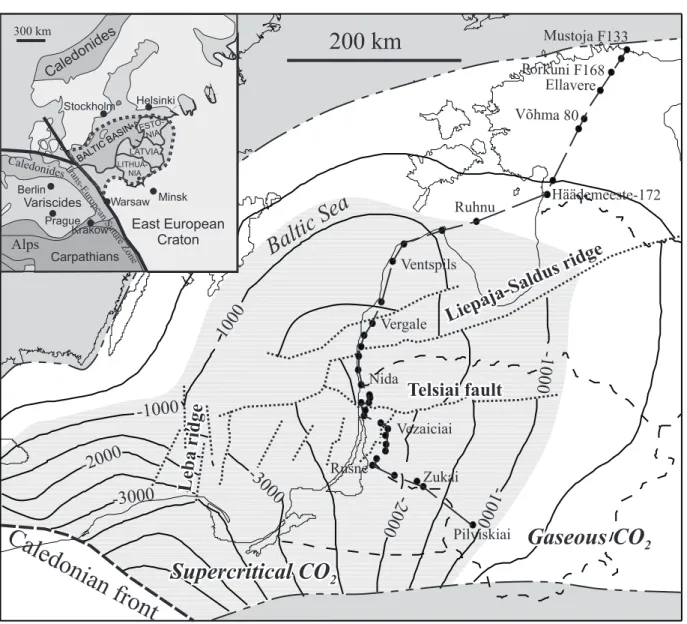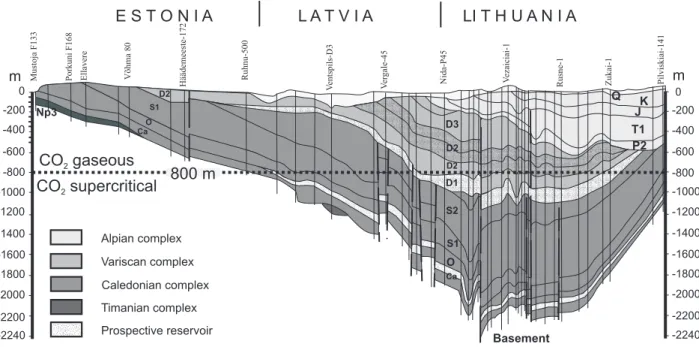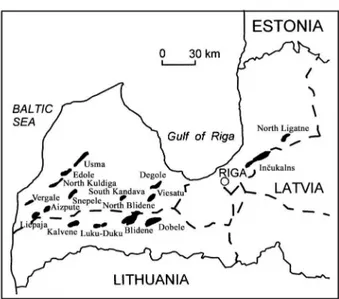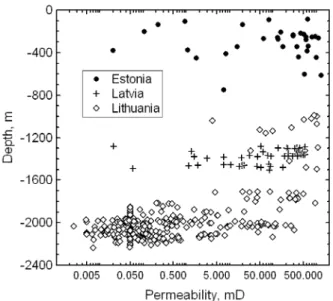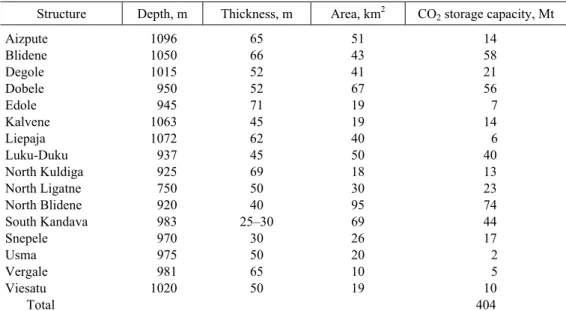The Baltic Basin: structure, properties of reservoir rocks, and capacity
for geological storage of CO
2Alla Shogenova
a, Saulius Sliaupa
b, c, Rein Vaher
a, Kazbulat Shogenov
a, and Raisa Pomeranceva
da
Institute of Geology at Tallinn University of Technology, Ehitajate tee 5, 19086 Tallinn, Estonia; alla@gi.ee b
Institute of Geology and Geography, T. Sevčenkos 13, LT-03223, Vilnius, Lithuania; sliaupa@lgt.lt c
Vilnius University, Universiteti St. 3, LT-01513, Vilnius, Lithuania; sliaupa@geo.lt d Latvian Environment, Geology and Meteorology Agency, Maskavas St. 165, Riga, Latvia
Received 18 June 2009, accepted 4 September 2009
Abstract. Baltic countries are located in the limits of the Baltic sedimentary basin, a 700 km long and 500 km wide synclinal structure. The axis of the syneclise plunges to the southwest. In Poland the Precambrian basement occurs at a depth of 5 km. The Baltic Basin includes the Neoproterozoic Ediacaran (Vendian) at the base and all Phanerozoic systems. Two aquifers, the lower Devonian and Cambrian reservoirs, meet the basic requirements for CO2 storage. The porosity and permeability of sandstone decrease with depth. The average porosity of Cambrian sandstone at depths of 80–800, 800–1800, and 1800–2300 m is 18.6, 14.2, and 5.5%, respectively. The average permeability is, respectively, 311, 251, and 12 mD. Devonian sandstone has an average porosity of 26% and permeability in the range of 0.5–2 D. Prospective Cambrian structural traps occur only in Latvia. The 16 largest ones have CO2 storage capacity in the range of 2–74 Mt, with total capacity exceeding 400 Mt. The structural trapping is not an option for Lithuania as the uplifts there are too small. Another option is utilization of CO2 for enhanced oil recovery (EOR). The estimated total EOR net volume of CO2 (part of CO2 remaining in the formation) in Lithuania is 5.6 Mt. Solubility and mineral trapping are a long-term option. The calculated total solubility trapping capacity of the Cambrian reservoir is as high as 11 Gt of CO2 within the area of the supercritical state of carbon dioxide.
Key words: Baltic Basin, reservoir rocks, CO2 geological storage, structural trapping.
INTRODUCTION
The composition and properties of reservoir rocks of the Baltic Cambrian basin were studied within the frame of the German–Baltic project GEOBALTICA ‘Characterisation of reservoir rocks and their fluids in the Baltic States’ and of the Estonian project ‘Physical properties of Estonian Palaeozoic sedimentary rocks: complex studies and systematic data base’ (Shogenova et al. 2001, 2002a, 2002b; Sliaupa et al. 2001, 2003; Jõeleht et al. 2002; Raidla et al. 2006).
Carbon dioxide capture and storage (CCS) is a new area of investigation in the three Baltic States (Estonia, Latvia, Lithuania). In 2006–2008 the Institute of Geology at Tallinn University of Technology, Institute of Geology and Geography (Vilnius), and Latvian Environment, Geology and Meteorology Agency participated in EU GEOCAPACITY and CO2NET EAST projects supported by the European Commission through Framework Programme 6 (FP6). As a result of the study several scientific articles were published (LEGMA 2007; Shogenova et al. 2008, 2009; Sliaupa et al. 2008), and the presently working CO2NET EAST information portals
for CCS technologies were created (www.gi.ee/co2net-east).
The aim of this article is to give an overview of the final results of several international and national projects focusing on the structure of the Baltic Basin, reservoir properties of rocks, and their application for CO2 geo-logical storage. Compared to the previously published data, a more precise formula was used for the estimation of CO2 storage capacity in saline aquifers, which was also applied in capacity estimates by all partners of the EU GEOCAPACITY project.
STRUCTURE
Latvia, 2300 m in western Lithuania, and 5000 m in Poland.
The Baltic Basin includes the Neoproterozoic Ediacaran (Vendian) at the base and all Phanerozoic systems. In this succession four structural complexes are distinguished, separated from each other by angular unconformity.
The Timanian (Baikalian) complex is composed of up to 200 m thick Ediacaran sandstone, siltstone, and claystone, and up to 120 m thick lowermost Cambrian claystone (‘Blue Clays’). They are distributed in the eastern half of the East Baltic countries.
The Caledonian complex includes the rest of the Cambrian succession (up to 170 m thick sandstone,
siltstone, and shale); 40–250 m thick Ordovician shaly-carbonaceous rocks; up to 800 m thick Silurian shale (in the shallow periphery of the basin carbonates pre-dominate); and over 200 m thick lowermost Devonian claystone, sandstone, and marlstone.
The Variscan (Hercynian) complex contains rest of the Devonian sequence (up to 1100 m thick marly-carbonaceous rocks alternating with sandstone) and the lowermost Carboniferous siliciclastic-carbonaceous rocks.
The Alpine complex includes an about 100 m thick Upper Permian succession of carbonates and evaporates; up to 250 m thick Lower Triassic mudstone; up to 120 m thick Jurassic sandstone, claystone, and limestone; 140 m
200 km
-1000
-1000
-2000
-3000
-3000
-1000
-1000
-2000
Caledonian front
Baltic
Sea
RuhnuVentspils
Vergale
Nida
Vezaiciai
Rusne
Zukai
Pilviskiai
Gas
eous
CO
2Liepaja-Saldus
ridge
Supercritical CO
2Telsiai fault
Leba ridge
Mustoja F133
Porkuni F168 Ellavere Võhma 80
H demeeste-172ää Variscides
Alps
Carpathians Caledonides
East European Craton
Baltic basin
Caledonides
Stockholm Helsinki
Berlin
Prague
Warsaw Minsk Krakow
300 km
Trans-European
Suture
Zone
LATVIA EST
O-NIA
LITHUA-NIA
BALTIC BASIN
thick Cretaceous glauconite sand and chalky marl; and 80 m thick Cenozoic siliciclastic rocks. The Cenozoic part of the section is known only in southwestern Lithuania. The bedrock is covered by Quaternary sediments varying in thickness from a few centimetres to a few hundred metres.
The end of the Caledonian tectonic stage was marked by the extensive faulting of the basin. The Variscan structural complex is less deformed (Fig. 2). Major faults are shown in Fig. 1. Numerous local structures (uplifts) have been detected in the Baltic Syneclise. In Lithuania 130 local Cambrian uplifts were identified (Šliaupa et al. 2005). On the tectonic map of Latvia (Misāns 1981)
109 local structures are indicated. Location of the 17 major Latvian local structures is shown in Fig. 3.
MATERIAL AND METHODS
The composition and physical properties were studied in samples collected during the GEOBALTICA project from 33 wells representing shallow (Estonia, 80–800 m), middle (Latvia and central Lithuania, 1–1.8 km), and deep (western Lithuania, 1.8–2.3 km) parts of the buried basin (Shogenova et al. 2001, 2002a, 2002b; Sliaupa et al. 2001, 2003; Jõeleht et al. 2002). Wet and grain density and effective porosity of 270 samples of Cambrian sandstones, siltstones, and claystones were
studied together with their bulk chemical composition in all three countries (Jõeleht et al. 2002). Bulk chemical composition of rocks was determined by X-ray-fluorescence (XRF) analysis in the All-Russian Geological Institute, St Petersburg.
Physical properties of 270 samples cut into cubes of 24 mm × 24 mm × 24 mm were measured in the
Petrophysical laboratory of Research Institute of Earth Crust of St Petersburg University using the following methods. Samples were dried at a temperature of 100– 110°C, and the weight of dry samples was determined
d
(q ). Next the samples were saturated with ordinary water for 7 days and then weighed in air (qw) and
water (qww). From the obtained measurements the
following parameters were calculated: wet density
w qw V qw (qw qww),
δ = = −
where V represents sample volume; grain density
g qd (qd qww),
δ = −
and effective porosity
e (qw qd) (qw qww).
Φ = − −
Gas permeability was measured in 36 Cambrian samples from Estonia, cut into cubes of 1 cm size,
V
ezaiciai-1
Rusne-1 Zukai-1 Pilviskiai-141
Nida-P45 V er gale-45 Mustoja F133 0 -200 -400 -600 -800 -1000 -1200 -1400 -1600 -1800 -2000 -2200 -2240 0 D3 D1 S2 S1 O P2 T1 JK Q Basement D2 -200 -400 -600 -800 -1000 -1200 -1400 -1600 -1800 -2000 -2200 -2240 V entspils-D3 Ruhnu-500 H demeeste-172 ää Ca
CO supercritical2
CO gaseous2
Porkuni F168 Ellavere Võhma 80
D1 800 m Np3 Ca D2 O S1
E S T O N I A L A T V I A LI T H U A N I A
Alpian complex Variscan complex Caledonian complex Timanian complex Prospective reser oirv
D2
m m
Fig. 3. Major Cambrian aquifer structures (CO2 storage potential
exceeding 2 Mt) of Latvia and Inčukalns underground gas
storage (modified after LEGMA 2007). The dashed line shows gas pipelines.
at the Hydrocarbon and Mineral Research Group, Danish Technical University using a DGP 2000 digital gas permeameter and the Software GASPERM V1.0 for Windows.
The permeability of 288 Lithuanian samples from 28 boreholes of central and western Lithuania and 68 Latvian samples from 6 boreholes was determined by the saturation method. The permeability and total weight of Cambrian rocks were measured on cubes of 2–4 cm size (depending on the diameter of the core). The samples were dried at a temperature of 105–110°C during 24 h and weighed (qd).
Permeability (in darcy) was determined during passing the gas through the sample using Zaks apparatus and calculated by the formula
1 2
( ),
K =Q l× ×η S t× × P−P
where Q is the gas volume passing through the sample (in cm3); l is sample length (cm); η is the dynamic viscosity of the gas; S is the square area of the cross section of the sample (cm2); t is time (in seconds); P1
is gas pressure in front of the sample (Mpa), P2 is gas
pressure behind the sample (Mpa). After that the samples were saturated with kerosene in vacuum and weighed in kerosene (qk). Then the samples were dried and weighed
in the air ( ).qs Effective porosity (%) was calculated by
the formula
e (qs qd) (qs qk).
Φ = − −
PHYSICAL PROPERTIES
A number of aquifers have been identified in the Baltic sedimentary basin. Deep (more than 800 m) saline aquifers, not suitable for drinking water supply, are considered as prospective ones for CO2 storage. Only
two large aquifers of the Baltic States meet these requirements, the Lower–Middle Devonian (Kemeri, Rėzekne, and Pärnu regional stages) and Cambrian
(Series 3, Deimena Formation).
The depth of the Cambrian reservoir (aquifer) exceeds 800 m in western Latvia, western Lithuania, northern Poland, and in the Baltic offshore, while Estonia is beyond the limit of the supercritical state of CO2 (Fig. 1). The thickness of the aquifer ranges from
20 to 70 m. The reservoir consists of quartz sandstone including interbeds of siltstone and shale (claystone). The wet density of these rocks increases with depth. The average density of samples from depths of 80–800, 800–1800, and 1800–2300 m is 2260 kg/m3 (60 samples), 2300 kg/m3 (111), and 2530 kg/m3 (98), respectively (Table 1). The porosity, on the contrary, decreases with depth (Fig. 4). The average porosity of samples from
Table 1. Values of physical and chemical parameters of the Baltic Cambrian rocks (modified after Sliaupa et al. 2003)
Depth, m
80–800 800–1800 1800–2300 Parameter
Min Max Mean N Min Max Mean N Min Max Mean N
Wet density, kg/m3 2070 2680 2260 60 2130 2810 2300 111 2400 2640 2530 98 Porosity, % 1.5 39.8 18.6 60 8.0 22.5 14.2 111 0.4 12.4 5.5 95 Permeability, mD 0.001 1292 311 38 0.02 1106 251 83 0.003 957 12 273 SiO2, % 62.0 88.6 83.3 60 57.0 99.4 89.3 115 61.1 99.8 89.7 98
Al2O3, % 0.4 17.7 5.3 60 0.05 16.6 3.6 115 0.05 14.6 4.3 98
CaO, % 0.03 16.5 2.2 60 0.03 11.1 0.6 115 0.03 6.4 0.7 98 ————————
Fig. 4. Porosity of Baltic Cambrian rocks versus depth.
depths of 80–800, 800–1800, and 1800–2300 m is 18.6% (60 samples), 14.2% (111), and 5.5% (95), respectively. The permeability has positive correlation with porosity and also decreases with depth (Figs 5, 6). Sandstone and siltstone samples showing the porosity of 20–32% have permeability in the range of 50–1300 mD. Rocks with the porosity of 1–6% have permeability of 0–10 mD. The Cambrian aquifer is sealed by a 500–900 m thick Ordovician–Silurian argillaceous carbonate cap rock.
The depth of the Lower–Middle Devonian reservoir (aquifer) exceeds 800 m only in western Lithuania (Fig. 7). The thickness of the aquifer ranges from 100 to 160 m.
Fig. 5. Permeability of Baltic Cambrian rocks versus depth.
Fig. 6. Permeability of Baltic Cambrian rocks versus porosity.
200 km
Caledonian front
Baltic Sea
-400 -200 -600 -800
-1000 -1000
-600
Vilnius Riga
Tallinn
Super critical
O
C 2
GaseousCO2
-200
Fig. 7. Depths of the top of the Lower–Middle (Pärnu– Kemeri) aquifer (after Sliaupa et al. 2008), shown by contour lines. The dotted lines show major faults. The pressure– temperature fields of gaseous (white) and supercritical (hatched) state of CO2 are indicated.
The reservoir consists of arkosic sandstone including interbeds of siltstone and shale (claystone). The average porosity is 26%, permeability ranges from 0.5 to 2 D. The aquifer is sealed by an 80–120 m thick Middle Devonian (Narva Formation) marlstone as cap rock (Sliaupa et al. 2008).
CAPACITY FOR STORAGE OF CO2
T > 31°C) depending on the formation pressures and
temperatures. In such conditions the density of CO2 is about 50–80% of the density of water. Carbon dioxide injected underground will fill the pore space by partial displacement of ‘in situ fluids’. The storage potential in saline formations ranges from a few per cent to more than 30% of the total rock volume. In hydrocarbon reservoirs most of the pore space is available for CO2 storage. After injection CO2 can be kept underground by a combination of physical and geochemical trapping mechanisms (Metz et al. 2005). Physical trapping includes structural (hydrodynamic) and residual trapping, while geochemical trapping consists of solubility and mineral trapping (Bachu et al. 1994; Metz et al. 2005; Suekane et al. 2008).
Structural trapping is the most important mechanism for storing CO2 in geological formations, when a huge amount of gas could be stored in domes covered by impermeable cap rocks. For structural trapping of CO2 local anticlinal structures are available in Latvia (LEGMA 2007). One of the 17 major West Latvian structures (Inčukalns, Fig. 3) has been used for under-ground gas storage since 1968, proving thus a long-range stability of the sealing cap rock (Davis et al. 2006).
The storage capacity of the structural trap is estimated by the formula (Pedersen et al. 2009; Vangkilde-Pedersen & Kirk 2009)
CO2t NG CO2r eff,
M =A× ×h × ×φ ρ ×S
where MCO2t is storage capacity (kg), A is the area of an aquifer in the trap (m2), h is the average thickness of
the aquifer in the trap, NG is an average net to gross ratio of the aquifer in the trap, φ is the average porosity
of the aquifer in the trap, ρCO2r is the in situ CO2 density at reservoir conditions, Seff is the storage efficiency factor (for trap volume).
The area of the structures has been determined from contour maps of stratigraphic horizons near or at the top of the reservoir formation. Thickness, net to gross ratio, and porosity have been evaluated using data from exploration wells drilled on the structure or extrapolating information from wells on nearby structures. The CO2 density varies with depth, depending on pressure and temperature and is in the range of 600–750 kg/m3 in Lithuania and Latvia. The aquifer systems surrounding and connected to the reservoir formations in the individual traps have been assumed to be open (unconfined) aquifers. The storage efficiency factor of 40% has been assumed corresponding to open high-quality reservoirs (Sliaupa et al. 2008; Vangkilde-Pedersen & Kirk 2009).
The 16 largest structures of Latvia have an estimated capacity of 2–74 Mt (Table 2). Their total estimated capacity exceeds 400 Mt. The depth of the reservoir is within the range of 900–1100 m, thickness 25–70 m, permeability of sandstone 300–700 mD, and average porosity 22%. Evaluation of the capacity of 116 Lithuanian local structures of the Cambrian aquifer showed that the two largest (Vaskai and Syderiai) can store only 8 and 21 Mt of CO2, respectively (Šliaupa et al. 2005). Capacity of the other structures is far less. No prospective structural traps have been found in the Lower–Middle Devonian aquifer.
Part of CO2 is trapped in the rock pores owing to capillary pressure. This trap mechanism is referred to as residual gas or capillary trapping (Dullien 1992, pp. 333–486; Suekane et al. 2008). Stuctural and residual trapping mechanisms of CO2 are available
Table 2. Physical parameters of the Latvian structural traps
Structure Depth, m Thickness, m Area, km2 CO2 storage capacity, Mt
Aizpute 1096 65 51 14
Blidene 1050 66 43 58
Degole 1015 52 41 21
Dobele 950 52 67 56
Edole 945 71 19 7
Kalvene 1063 45 19 14
Liepaja 1072 62 40 6
Luku-Duku 937 45 50 40
North Kuldiga 925 69 18 13
North Ligatne 750 50 30 23
North Blidene 920 40 95 74
South Kandava 983 25–30 69 44
Snepele 970 30 26 17
Usma 975 50 20 2
Vergale 981 65 10 5
Viesatu 1020 50 19 10
not only in aquifers, but also in depleted oil fields. They are represented by local anticlinal traps (mostly brachy-anticlines) containing oil. Some oil shows and a small Kuldiga oil field were discovered in Cambrian and Ordovician reservoirs in Latvia (Brangulis et al. 1993). In Lithuania, 15 commercial oil fields are associated with Cambrian sandstone, 3 are located in Silurian reefs, and 1 lies in the Ordovician reservoir. Oil of all fields is light (807–836 kg/m3), of methane type. Preliminary geological reserves range from 0.15 to 3.11 million tonnes (Zdanavičiūtė & Sakalauskas 2001). Eleven oil fields are presently exploited. The storage potential of the two largest oil fields in West Lithuania reaches 2 Mt CO2. Another option is utilization of CO2 for enhanced oil recovery (EOR). Most of the oil fields have reached the tail phase, and EOR can prolong their life. The estimated total EOR net volume of CO2 is 5.6 Mt.
A small oil deposit was discovered in western Latvia in 1963 (Kuldiga area). The oil pool is associated with the top of Cambrian sandstone. The reserves were evaluated in the range of 0.08–0.31 million cubic metres. More than 10 anticlinal structures prospective for oil exploration were identified in the Latvian offshore area. Potential CO2 storage in the prospective offshore oil fields is a task for future study.
Geochemical trapping is not restricted to particular structures. It occurs when CO2 reacts with in situ fluids (solubility trapping) and host rock (mineral trapping) over time scales of hundreds to thousands of years. At the aquifer scale dissolution is relatively slow due to the difference in the densities of water saturated with CO2 and unsaturated water (Ennis-King & Paterson 2003). The solubility of CO2 in the Cambrian aquifer varies from 25–30 kg/m3 in West Lithuania to 40–50 kg/m3 in East Lithuania and Latvia. The CO2 storage potential changes westwards from 0.4 to 0.05 Mt/km2. The calculated total solubility trapping capacity is as high as 11 Gt CO2 within the area of the supercritical state of carbon dioxide (Sliaupa et al. 2008).
The Lower–Middle Devonian aquifer is characterized by better reservoir properties, but has a smaller area than the Cambrian reservoir. Carbon dioxide solubility ranges from 36 kg/m3 in the deep part of the basin to 60 kg/m3 in the periphery of the basin. In West Lithuania the storage capacity of the reservoir is about 1 Mt CO2 in a 1 km2 area. The total onshore potential of this formation is estimated as high as 1 Gt CO2 (Sliaupa et al. 2008).
Mineral trapping that involves a series of interactions between the formation mineralogy and CO2-enriched aquifer waters, can convert CO2 to carbonate. The Cambrian reservoir comprises quartz sandstone that is practically not reactive to carbon dioxide. The Lower– Middle Devonian sandstone contains clay admixture (up to 10%) and feldspar grains (up to 15%). Therefore they have a potential for permanent immobilization of carbon
dioxide in mineral form. Assuming the rock capacity of 10 kg/m3, the sequestration potential can be evaluated to reach 5.6 Gt CO2 (onshore) (Sliaupa et al. 2008).
CONCLUSIONS
Baltic countries are situated within the Baltic sedimentary basin, which is a large marginal synclinal structure in the southwestern part of the East European Craton. The axis of the syneclise plunges to the southwest, and depth below sea level of the Precambrian basement increases to 2300 m in western Lithuania. The Baltic Basin includes the Neoproterozoic Ediacaran (Vendian) at the base and all Phanerozoic systems. In this succession four structural complexes (Timanian, Caledonian, Variscan, and Alpian) are distinguished.
Two aquifers, the Lower–Middle Devonian and Cambrian reservoirs, meet the basic requirements for CO2 storage. Only Latvia has prospective structural traps. The 16 largest ones have the storage capacity of 2–74 Mt CO2, whereas the total capacity exceeds 400 Mt. The structural trapping is not an option for Lithuania as the uplifts are too small. The storage potential of the largest oil fields in West Lithuania reaches 2 Mt CO2. Another option is utilization of CO2 for enhanced oil recovery (EOR). The estimated total EOR net volume of CO2 (part of CO2 remaining in the formation) is 5.6 Mt.
Alternatively, the solubility trapping could be considered as having a high potential. The calculated total solubility trapping capacity is as high as 11 Gt CO2 within the area of the supercritical state of carbon dioxide. Lower–Middle Devonian sandstone has a potential for permanent immobilization of carbon dioxide in mineral form, the sequestration potential can reach 5.6 Gt CO2 (onshore). The solubility trapping together with the mineral trapping should cover industry needs for hundreds of years. However, solubility and mineral trapping technologies are still immature. Several problems have to be solved to activate this potential, such as dissolution enhancement, monitoring, etc.
Estimation of storage potential offshore in the Baltic Sea needs new exploration data and research.
REFERENCES
Bachu, S., Gunter, W. D. & Perkins, E. H. 1994. Aquifer disposal of CO2: hydrodynamic and mineral trapping.
Energy Conversion and Management, 35, 269–279.
Brangulis, A. P., Kanev, S. V., Margulis, L. S. & Pome-rantseva, R. A. 1993. Geology and hydrocarbon prospects of the Paleozoic in the Baltic region. In Petroleum Geology of NW Europe. Proceedings of the 4th Conference,
March–April, 1992 (Parker, J. R., ed.), pp. 651–656.
Geological Society, London.
Davis, A., Jesinska, A., Kreslins, A., Zebergs, V. & Zeltins, N. 2006. Increasing role of underground gas storages for reliable supply of gas to Latvia, Lithuania, Estonia, Finland and NW Russia and prospects of development of Incukalns underground gas storage. In 23rd World Gas
Conference, Amsterdam. CD.
Dullien, F. A. L. 1992. Porous Media Fluid Transport and
Pore Structure, 2nd ed. Academic Press, San Diego,
567 pp.
Ennis-King, J. & Paterson, L. 2003. Rate of dissolution due to convection mixing in the underground starge of carbon dioxide. In Proceedings of the 6th International Conference on Greenhouse Gas Control Technologies,
Vol. 1 (Gale, J. & Kaja, Y., eds), pp. 501–510. Pergamon.
Jõeleht, A., Kirsimäe, K., Shogenova, A., Šliaupa, S., Kukkonen, I. T., Rasteniene, V. & Zabele, A. 2002. Thermal conductivity of Cambrian siliciclastic rocks from the Baltic basin. Proceedings of the Estonian
Academy of Sciences, Geology, 51, 5–15.
[LEGMA] Latvian Environment, Geology and Meteorology Agency. 2007. Geological Structures for the
Establish-ment of Underground Gas Storages. Riga, 16 pp.
Metz, B., Davidson, O., de Coninck, H., Loos, M. & Meyer, L. (eds). 2005. IPCC Special Report. Carbon Dioxide Capture and Storage. Summary for Policymakers
and Technical Summary, 53 pp. [http://www.ipcc.ch,
accessed 7 Sept. 2009].
Misāns, J. (ed.). 1981. Latvijas PSR tektoniskā karte. Mērogs
1:500 000. Latvijas PSR Ģeoloģijas Pārvalde, Leningrad, 2 sheets.
Paškevičius, J. 1997. The Geology of the Baltic Republics. Vilnius University, Geological Survey of Lithuania, Vilnius, 387 pp.
Raidla, V., Kirsimäe, K., Bitjukova, L., Jõeleht, A., Shogenova, A. & Šliaupa, S. 2006. Lithology and diagenesis of the poorly consolidated Cambrian silici-clastic sediments in the northern Baltic Sedimentary Basin. Geological Quarterly, 50, 395–406.
Shogenova, A., Kirsimäe, K., Bitjukova, L., Jõeleht, A. & Mens, K. 2001. Physical properties and composition of cemented siliciclastic Cambrian rocks, Estonia. In
Research in Petroleum Technology (Fabricius, I. L., ed.),
pp. 123–149. Nordisk Energiforskning, Ås, Norway. Shogenova, A., Jõeleht, A., Kirsimäe, K., Šliaupa, S.,
Rasteniene, V. & Zabele, A. 2002a. Electric properties of siliciclastic rocks in the Baltic Cambrian basin.
In Proceedings of the 6th Nordic Symposium on
Petro-physics, 15–16 May, 2001 (Backe, K. & Loermans, T.,
eds). Nordic Energy Research Programme, Norwegian University of Science and Technology, Trondheim,
Norway, 14 pp. [CD; http://www.ipt.ntnu.no/nordic, accessed 7 Sept. 2009].
Shogenova, A., Mens, K., Sliaupa, S., Rasteniene, V., Jõeleht, A., Kirsimäe, K., Zabele, A. & Freimanis, A. 2002b. Factors influenced porosity of the siliciclastic rocks in the Baltic Cambrian basin. In Extended Abstracts, Vol. 2, 64th EAGE Conference and Technical Exhibition, Florence,
26–30 May 2002. European Association of Geoscientists
& Engineers, Ladenius Communicate, Houten. P218, 4 pp. Shogenova, A., Sliaupa, S., Shogenov, K., Sliaupiene, R., Pomeranceva, R., Uibu, M. & Kuusik, R. 2008. CO2
geological storage and mineral trapping potential in the Baltic region. Slovak Geological Magazine, 5–14. Shogenova, A., Šliaupa, S., Shogenov, K., Šliaupienė, R.,
Pomeranceva, R., Vaher, R., Uibu, M. & Kuusik, R. 2009. Possibilities for geological storage and mineral trapping of industrial CO2 emissions in the Baltic region.
Energy Procedia, 1, 2753–2760.
Sliaupa, S., Rasteniene, V., Lashkova, L. & Shogenova, A. 2001. Factors controlling petrophysical properties of Cambrian siliciclastic deposits of Central and Western Lithuania. In Research in Petroleum Technology (Fabricius, I. L., ed.), pp. 157–180. Nordisk Energi-forskning, Ås, Norway.
Sliaupa, S., Hoth, P., Shogenova, A., Huenges, E., Rasteniene, V., Freimanis, A., Bityukova, L., Joeleht, A., Kirsimäe, K., Laskova, L. & Zabele, A. 2003. Characterization of Cambrian reservoir rocks and their fluids in the Baltic
States (CAMBALTICA). In Cleaner Energy Systems
Through Utilization of Renewable Geothermal Energy
Resources (Bujakowski, W., ed.), pp. 61–73. Kajc,
Krakow.
Šliaupa, S., Satkūnas, J. & Šliaupienė, R. 2005. Prospects of geological disposal of CO2 in Lithuania. Geologija
(Vilnius), 51, 20–31 [in Lithuanian, with English
summary].
Sliaupa, S., Shogenova, A., Shogenov, K., Sliaupiene, R., Zabele, A. & Vaher, R. 2008. Industrial carbon dioxide emissions and potential geological sinks in the Baltic States. Oil Shale, 25, 465–484.
Suekane, T., Nobuso, T., Hirai, S & Kiyota, M. 2008. Geo-logical storage of carbon dioxide by residual gas and solubility trapping. International Journal of Greenhouse
Gas Control, 2, 58–64.
Vangkilde-Pedersen, T. & Kirk, K. (eds). 2009. FP6 EU GeoCapacity Project, Assessing European Capacity for
Geological Storage of Carbon Dioxide, Storage Capacity.
D26, WP4 Report Capacity Standards and Site Selection
Criteria. Geological Survey of Denmark and Greenland,
45 pp. [http://www.geology.cz/geocapacity/publications, accessed 5 Oct. 2009].
Vangkilde-Pedersen, T., Lyng Anthonsen, K., Smith, N., Kirk, K., Neele, F., van der Meer, B., Le Gallo, Y., Bossie-Codreanu, D., Wojcicki, A., Le Nindre, Y.-M., Hendriks, C., Dalhoff, F. & Christensen, N. P. 2009. Assessing European capacity for geological storage of carbon dioxide – the EU GeoCapacity project. Energy
Procedia, 1(1), 2663–2670.
Zdanavičiūtė, O. & Sakalauskas, K. (eds). 2001. Petroleum
Geology of Lithuania and Southeastern Baltic. Institute
of Geology, Vilnius, 204 pp.
